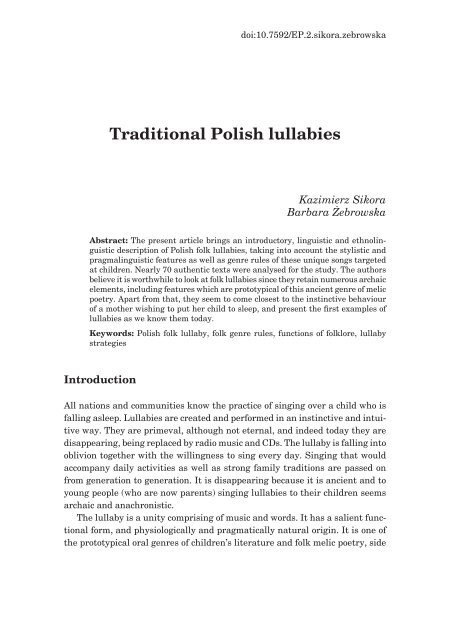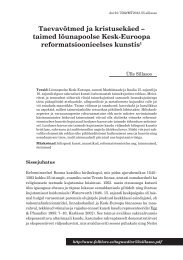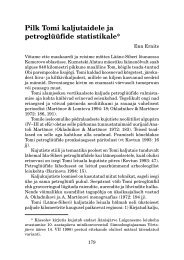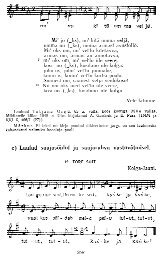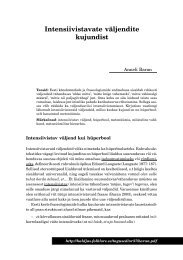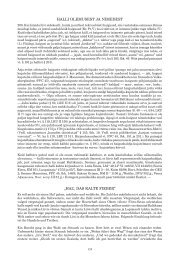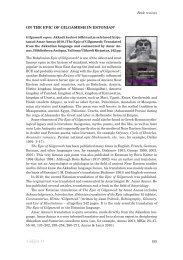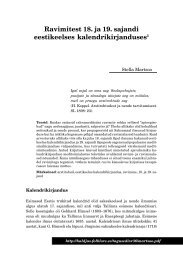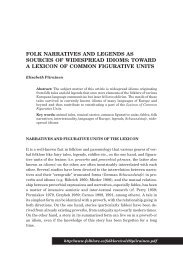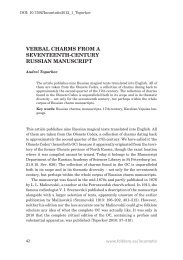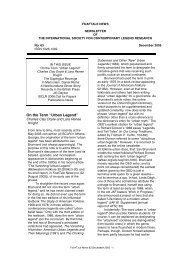You also want an ePaper? Increase the reach of your titles
YUMPU automatically turns print PDFs into web optimized ePapers that Google loves.
doi:10.7592/EP.2.sikora.zebrowska<br />
<strong>Traditional</strong> <strong>Polish</strong> <strong>lullabies</strong><br />
Kazimierz Sikora<br />
Barbara Żebrowska<br />
Abstract: The present article brings an introductory, linguistic and ethnolinguistic<br />
description of <strong>Polish</strong> folk <strong>lullabies</strong>, taking into account the stylistic and<br />
pragmalinguistic features as well as genre rules of these unique songs targeted<br />
at children. Nearly 70 authentic texts were analysed for the study. The authors<br />
believe it is worthwhile to look at folk <strong>lullabies</strong> since they retain numerous archaic<br />
elements, including features which are prototypical of this ancient genre of melic<br />
poetry. Apart from that, they seem to come closest to the instinctive behaviour<br />
of a mother wishing to put her child to sleep, and present the first examples of<br />
<strong>lullabies</strong> as we know them today.<br />
Keywords: <strong>Polish</strong> folk lullaby, folk genre rules, functions of folklore, lullaby<br />
strategies<br />
Introduction<br />
All nations and communities know the practice of singing over a child who is<br />
falling asleep. Lullabies are created and performed in an instinctive and intuitive<br />
way. They are primeval, although not eternal, and indeed today they are<br />
disappearing, being replaced by radio music and CDs. The lullaby is falling into<br />
oblivion together with the willingness to sing every day. Singing that would<br />
accompany daily activities as well as strong family traditions are passed on<br />
from generation to generation. It is disappearing because it is ancient and to<br />
young people (who are now parents) singing <strong>lullabies</strong> to their children seems<br />
archaic and anachronistic.<br />
The lullaby is a unity comprising of music and words. It has a salient functional<br />
form, and physiologically and pragmatically natural origin. It is one of<br />
the prototypical oral genres of children’s literature and folk melic poetry, side
Kazimierz Sikora & Barbara Żebrowska<br />
by side with the counting songs or poems. It is a border area between literature<br />
and folklore; a syncretic genre linking linguistic, musical, psychological and<br />
cultural aspects (cf. Jeziorkowska-Polakowska 2010). The lullaby usually constitutes<br />
the infant’s first contact with poetry and music, even before he or she<br />
starts speaking. The folk lullaby has been a constant source of inspiration for<br />
many varieties of lyrical poetry for children. Many lyrical <strong>Polish</strong> carols such as<br />
Lulajze Jezuniu (‘Sleep well, little Jesus’) are based on the genre of folk <strong>lullabies</strong>.<br />
It also has other numerous artistic continuations such as the famous lullaby<br />
by Krzysztof Komeda from the film “Rosemary’s baby“, directed by Roman<br />
Polański. The texts of <strong>lullabies</strong> were transmitted orally, and always by being<br />
sung, hence their formulaity and the presence of very many variants (see also<br />
Sarv 2013, this volume, about improvisation in folk <strong>lullabies</strong>).<br />
On the whole, <strong>Polish</strong> scholars have paid little attention to <strong>lullabies</strong>. This has<br />
stemmed from their irrational conviction that <strong>lullabies</strong> are a permanent feature<br />
of all cultures. Because of the lack of interest in collecting <strong>lullabies</strong>, they have<br />
never become a subject of serious research in <strong>Polish</strong>; many of them have been<br />
forgotten and today it is very difficult to find reliable informers for collecting<br />
<strong>lullabies</strong>. The lack of ready scholarly studies makes interested researchers seek<br />
for information about <strong>lullabies</strong> from various places, sometimes finding only<br />
very insufficient pieces of material.The primeval nature and prototypicality<br />
of <strong>lullabies</strong> encourage researchers to undertake comparative studies 1 . We will<br />
start from presenting three selected examples of <strong>Polish</strong> folk <strong>lullabies</strong> 2 .<br />
1<br />
This article will address only <strong>Polish</strong> <strong>lullabies</strong>; only selected problems of their structure<br />
and pragmatics will be discussed here.<br />
2<br />
We have drawn the texts from the radio archive recordings avalable as a series of<br />
CDs as part of the <strong>Polish</strong> radio folk collection – Sources of <strong>Polish</strong> folk music. Later in<br />
the text we use the identifying abbreviation PRFolkColl+No of the CD. As a sidenote<br />
we would like to add that in 2010, a special album came out (No 27) which contains<br />
numerous <strong>lullabies</strong> and counting songs, and is titled “Wokół Dziecka. Kołysanki i<br />
pieśni dziecięce” (’Around the child. Lullabies and children songs’). The CD proved to<br />
be a musical bestseller. The value of the recordings encouraged us to share with the<br />
readers these particular <strong>lullabies</strong>, although the findings concerning the <strong>Polish</strong> folk<br />
lullaby presented in the article have been made on the basis of the material collected<br />
from the entire collection of ca 70 <strong>lullabies</strong>. We cannot quote them all here for the<br />
lack of space.<br />
178
<strong>Traditional</strong> <strong>Polish</strong> <strong>lullabies</strong><br />
Example 1. Lullaby from Lublin area (PRFolkColl.3).<br />
Oj lulaj, lulaj (bis)<br />
Siwe óczka stulaj<br />
Oj, siwe ocie stulisz<br />
do mnie się przytulisz (bis)<br />
Oj lulaj, lujaj/ (bis)<br />
Maleńki sukole<br />
Oj, jak ty mie urośniesz<br />
Pójdziesz ze mną w pole/ (bis)<br />
Kołysz mi się, kołysz<br />
kolibejko lipia<br />
Oj, niechże cię, synuniu<br />
Łóziuniu usypia/ (bis)<br />
Kołysz mi się, kołysz<br />
od ściany do ściany<br />
to ja ci uwiję<br />
wianecek ruciany<br />
Go to sleep, go to sleep<br />
close your blue eyes<br />
if you close your blue eyes<br />
you’ll cuddle up to me<br />
Go to sleep, go to sleep<br />
you little falcon<br />
when you grow<br />
we’ll go to the field<br />
179
Kazimierz Sikora & Barbara Żebrowska<br />
Rock and rock<br />
lime tree cradle<br />
Oh, sonny boy, let<br />
the cot put you to sleep<br />
Rock and rock<br />
from side to side<br />
and I’ll weave for you<br />
a rue wreath 3<br />
Example 2. Lullaby from southern Mazovia (PRFolkColl.1).<br />
Uśnijże mi uśnij/<br />
albo mi urośnij/<br />
Przydasz mi się przydasz/<br />
w pole wółki wygnasz. (bis)<br />
Jeszczem nie urosła/<br />
jużem się przydała/<br />
Jużem se wółeńki/<br />
w póleńko wygnała/ (bis)<br />
Jeszczem nie urosła/<br />
mamuni do kostek/<br />
U mojej mamuni/<br />
chłopców pełen mostek/ (bis)<br />
Jeszczem nie urosła/<br />
mamuni do kolan/<br />
U mojej mamuni/<br />
Zalotniki stojo/ (bis)<br />
3<br />
Ruta or rue (Ruta Graveolens) – the plant believed to be connoted with female infidelity.<br />
180
<strong>Traditional</strong> <strong>Polish</strong> <strong>lullabies</strong><br />
Jeszczem nie urosła/<br />
mamuni do pasa/<br />
U mojej mamuni/<br />
Gorzałeczki flasa/ (bis)<br />
Jeszczem nie urosła/<br />
mamuni do szyi/<br />
U mojej mamuni/<br />
gorzałecke pijo/ (bis)<br />
Do go to sleep for me, go to sleep<br />
or grow for me<br />
you’ll be useful to me<br />
you’ll send the oxen to the field<br />
I haven’t grown yet<br />
I am already useful<br />
I have sent the little oxen to the field already<br />
I haven’t grown yet<br />
to my mommy’s ankles<br />
at my mommy’s place there are boys and boys<br />
I haven’t grown yet<br />
to my mommy’s knees<br />
at my mommy’s place the suitors stand<br />
I haven’t grown yet<br />
to my mommy’s waist<br />
at my mommy’s place<br />
there’s a flask of vodka<br />
I haven’t grown yet<br />
to my mommy’s neck<br />
at my mommy’s place<br />
vodka is being drunk<br />
181
Kazimierz Sikora & Barbara Żebrowska<br />
Example 3. Lullaby from Kurpie (Zielona forest; PRFolkColl.6).<br />
A lulaj, lulaj małe dziecie<br />
Panu Bogu cie pol’yce<br />
i Najśwantsyj Panianecce<br />
żebyś spało w kol’ybecc(e). (bis)<br />
Lulaj, lulaj do ziecora<br />
aż ci matka przyjdzie z pola.<br />
Przyniesie ci kacke i kacor(a).<br />
A z tej kacki drobne flacki,<br />
a z kacora duze koła.<br />
Lulaj, lulaj moje dziecie<br />
pojedziamy do kościo(ła).<br />
Lulaj, lulaj do ziecora<br />
aż ci matka przyjdzie z pol(a).<br />
Lulaj, lulaj stari hulaj,<br />
a hulajka psiekła jåjka.<br />
Usiadła sie na zapsiecku<br />
psiekła jåjka w tygielec(ku). (bis)<br />
Go to sleep, go to sleep little baby<br />
I will entrust you to God<br />
and the holiest Virgin<br />
so you have your little cot to sleep in<br />
Go to sleep, go to sleep until the evening<br />
when your mother comes from the field<br />
she’ll bring you a duck and a gander.<br />
182
<strong>Traditional</strong> <strong>Polish</strong> <strong>lullabies</strong><br />
From the duck she’ll make fine tripe<br />
from the gander large wheels.<br />
Go to sleep, go to sleep my little baby<br />
we’ll ride to the church.<br />
Go to sleep go to sleep until the evening<br />
when your mother comes from the field.<br />
Go to sleep, go to sleep, old reveller<br />
the reveller woman baked some eggs.<br />
She sat on the heated seat by the stove<br />
and baked eggs in a crucible.<br />
Lullaby – the quintessence of pragmatics and<br />
psychology<br />
An attempt at a definition of a lullaby must take into account the fact that lulling<br />
a baby with singing and swinging is one of the most primeval behaviours of<br />
the human being. Mothers have always done it; they lulled their child, which<br />
is an activity typical for all ethnic groups, a basic archetypical model of behaviour.<br />
This is most probably confirmed by the proto-Indo-European origin of<br />
this word stem (Pol. lulac, lulaj; Eng. lullaby; Hebrew lajla-tow, meaning ‘good<br />
night’; cf. Jeziorkowska-Polakowska 2010). Another significant and persistent<br />
similarity is displayed by its narrow melodic range, slow tempo, and diversity<br />
of the verbal layer of these songs. That is why <strong>lullabies</strong> may assume an array<br />
of different forms: from monotonous iterations of onomatopoetic exclamations<br />
which occur while swinging the baby (aaa! luli luli la! etc.) to elaborate poetic<br />
forms. Lullabies can frequently be popular lyrical songs sung by adults, which<br />
are then accommodated to the situation of lulling a child to sleep. Theoretically,<br />
one could sing any song, only it has to have a “soothing power”. Still, scholars<br />
emphasise that an authentic lullaby must focus on a child (the addressee of the<br />
partner in dialogue; cf. Cieślikowski 1975). Presenting an univocal definition<br />
of the lullaby is not entirely possible.<br />
The attempts at the definition of the lullaby mention the following elements:<br />
it has a lyrical melody, the folk song is sung in 3/4 or 3/8 time 4 (cf. Śmiechowski<br />
1999). Its rhythm and melody are also argued to serve a clear purpose – that<br />
of putting the child to sleep (cf. Cieślikowski 1985). The dominant convention<br />
requires that the person putting the child to sleep sings quietly, softly and<br />
tenderly. The aim, after all, is to ensure a sense of physical and mental safety<br />
4<br />
However, as the collected material demonstrates, this is not a necessary condition.<br />
183
Kazimierz Sikora & Barbara Żebrowska<br />
for the baby, and this is based on the closeness of the loving mother. In the case<br />
of folk <strong>lullabies</strong>, it seems crucial to us that their refrains and phrases clearly<br />
harmonise with the swinging movement of the hands or the cot (or sometimes<br />
a basket hanging on a rope). It is the very swinging itself (and the equipment<br />
which is supposed to aid the swinging) that determins the rhytm and melody<br />
of the lullaby 5 .<br />
Creating his own definition, Valentin Golovin draws attention to the physiology<br />
of sleep, or more specifically to its different phases. Lullabies are songs<br />
addressed at the baby who is in a transitional phase between being awake and<br />
sleeping. The songs try to help him to move from one stage into another (2000:<br />
30). This function comprises the following elements: melody, rhythmic pattern,<br />
poetics, harmony (phonetics), motives and images which help the child to calm<br />
down, to become drowsy, melancholic, to have dreamy imagery (ibid.). From<br />
the point of view of psychology, lullaby carries an “ilinctic” function (serves the<br />
purpose of calming down the child, making it sleepy, limiting external stimuli<br />
within the reach of the baby; cf Budrewicz 1996: 280). Without such quieting,<br />
which included soothing the fears and getting rid of bad emotions, sleep will<br />
not come.<br />
The prototypical lullaby, as has been shown in the previous examples (see<br />
above, Examples 1–3), always has the nature of oration and dialogue. But the<br />
dialogue with the infant at the breast is only apparent as it engages emotions<br />
but not intellectual reasoning. The listener, i.e. the baby, may be a partner only<br />
in an emotional sense but not the linguistic one, since it cannot participate in<br />
verbal communication. It is clear that <strong>lullabies</strong> often have the form of a concealed<br />
wish. Words have magical power – they function in accordance with magical<br />
thinking. Hence iterated commands like ‘Go to sleep, go to sleep’, ‘Grow, grow’,<br />
‘You’ll be useful to me, you’ll be useful’ are being sung, as seen in our examples<br />
as well. It is generally believed in Poland that one grows while asleep. Wish is<br />
a concealed directive speech act, hence in <strong>lullabies</strong> there are frequent appeals<br />
to Our Lady, Lord Jesus (as she was also a mother, and He was a child) or to<br />
various anthropomorphised objects with which the child has contact, such as<br />
its little bed, cot, pillow, or quilt. A rich repertoire of emotional and intellectual<br />
persuasion is required here.<br />
The <strong>lullabies</strong> are to assist the mother to put the child to sleep and even if<br />
the songs are reworked and used for other purposes, they always bring the<br />
state of calm, dreaminess, melancholy or monotony 6 . That is why what is finally<br />
considered to be typical <strong>lullabies</strong> are those songs which have been created in<br />
order to achieve the intended effect – putting the child to sleep – and display<br />
5<br />
The melodies of <strong>Polish</strong> folk <strong>lullabies</strong> require a scholarly analysis, but due to insufficient<br />
documentation this might constitute a challenge for potential researchers.<br />
6<br />
Monotony leads to tiredness and that in turn leads to falling asleep.<br />
184
<strong>Traditional</strong> <strong>Polish</strong> <strong>lullabies</strong><br />
characteristic features which help reaching the aim such as dreamy imagery<br />
or a quiet monotonous melody and rhythmic pattern synchronised with the<br />
swinging movement of the cot or mother’s hands.<br />
Ach, śpij, Kochanie! Putting a child to sleep in a<br />
<strong>Polish</strong> way<br />
Creating an atmosphere which helps the child to fall asleep<br />
For the lullaby to meet its principle aim, it must be accompanied by other<br />
sleep-evoking elements than only those mentioned above 7 . What is decisive<br />
is the physical closeness of the mother and child: in the old times, the infant,<br />
for the first few days of his life, practically never left mother’s arms. As it was<br />
believed, the unbaptised children can in this way only be protected from evil<br />
(Ogrodowska 2007: 62). The mother swings the baby in her arms, carries it<br />
around and talks to it. The baby cries, and mother’s onomatopoetic exclamations<br />
appear spontaneously and naturally; among them echolalia, glossolalia (aaa,<br />
luli laj, alulu, cf. Budrewicz 1996: 280), humming, swinging and other instinctive<br />
and atavistic behaviours. Verbal behaviours are to sustain and enhance<br />
the baby’s impression of being swung.<br />
Another factor is the presence of the cot. The cot ideally imitates being swung<br />
in the mother’s arms and appears in many <strong>lullabies</strong>. What is more, it is even<br />
occasionally addressed directly which stems from the tendency of the village<br />
population to anthropomorphise the world. In the old days, mothers weaved,<br />
sewed, cooked etc., and at the same time, pushed the rocking cot. They moved<br />
it with a leg and sang quietly when the child was crying. Alternatively, they<br />
pushed the basket in which the child was lying with the free hand. In order<br />
to take the child along to the fields where the mother was working, cots were<br />
made of thick fabric, tarpaulin, or a blanket. The cot was hung on crossed<br />
sticks or on the shaft of the horse carriage (cf. Ogrodowska 2007: 64). For the<br />
<strong>Polish</strong> peasants, the cot was the first equipment the human being needed, and<br />
was regarded as essential in taking care of a baby. That is why even in <strong>Polish</strong><br />
carols, Messiah was put into a cot (cf. Budrewicz 1996: 278).<br />
Persuasion contained in <strong>lullabies</strong> is evoked by several emotional strategies.<br />
They are oriented first of all to the use of the conative function of language,<br />
but also the expressive function because frequently they give rise to emotions<br />
(particularly characterising the attitude of the mother to the baby). We will<br />
classify the emotional strategies, taking into account their pragmatic aspects.<br />
7<br />
Of course, quieting the baby down is most important, as without it he baby cannot<br />
fall asleep.<br />
185
Kazimierz Sikora & Barbara Żebrowska<br />
Strategy of affective expressions and diminutives<br />
The presence of the strategy of affective expressions and diminutives is understandable,<br />
because scholars emphasise that the period from birth up until approximately<br />
the third year of age is the time when emotions are spontaneously<br />
and unconventionally demonstrated (cf. Sawicka 2000). A lullaby is the domain<br />
of positive emotions (love, adoration, tenderness, delight) which in the <strong>Polish</strong><br />
language have morphological indicators – diminutives and hypocoristic names<br />
or words, even of the third degree (for example, Kaziuniuniu kochaniuteńki).<br />
Affective expressions and diminutives directly enhance the persuasive function.<br />
Replacing the name with an affectonym or some other affective expression<br />
is very common practice in the <strong>Polish</strong> language. All names transform in this<br />
way, and their pleasant sound will encourage the child to fall asleep. They are<br />
abundant in <strong>lullabies</strong> and reflect the positive emotion of the singer.<br />
Strategies of argumentation<br />
A lullaby can also explain to the baby that it should fall asleep. Since the baby<br />
by nature desires acceptance and love, and wants the parents to be satisfied<br />
with their behaviour, then it is also able to understand that the mother must<br />
go to work (A śpijże mi, śpijże / od samego rana / bo matuś musi iść / na łąkę<br />
do siana... , ‘Oh sleep, oh sleep / until the morning / as mommy must go to the<br />
meadow / to get hay...’). One can persuade the baby so that it is no longer afraid<br />
of falling asleep because it will be guarded by a Guardian Angel, Our Lady,<br />
Lord Jesus, etc. (Uśnijże mi uśnij / Pan Jezus cię uśpi / aniołek obudzi / wstań<br />
Jasiu do ludzi, ‘Oh fall asleep, oh fall asleep / Lord Jesus will put you to sleep<br />
/ the little angel will wake you up / get up, Jasiu, and go to the people’). One<br />
can also explain to the child that it will grow faster when asleep, and that in<br />
turn would help their mother.<br />
The strategy of threatening<br />
Threats in <strong>Polish</strong> <strong>lullabies</strong> are rather jocular in essence, and also rather rare,<br />
but in spite of that they should be described here, as they present an interesting<br />
aspect of how to affect the baby’s imagination. Most frequently, they display<br />
the schema “if you don’t fall asleep, then you will be cast out of the house, into<br />
the woods, and even thrown into the river”. We can see how desperate the<br />
mother of a restless baby could have been (Lulajże mi, lulaj / bo cię wrzucę w<br />
dunaj / z dunaja do jazu / utoniesz od razu, ‘Fall asleep, fall asleep / because<br />
186
<strong>Traditional</strong> <strong>Polish</strong> <strong>lullabies</strong><br />
I will throw you into the river / and then from the river into the weir / you’ll<br />
drown right away’). Russian <strong>lullabies</strong> tend to be frightening too – the result<br />
of which is that the child will become scared, and will become quiet, and fall<br />
asleep (Golovin 2000).<br />
The strategy of promise<br />
The strategy of promise consists in pointing out the reward which the baby will<br />
get when it falls asleep. It is promised something good to eat, or alternatively<br />
an object or an animal to play with, or some other pleasant activity. Both the<br />
threat and the promise may be used, i.e. the stick and the carrot (Śpij dzieciatko<br />
śpij / dam ci jabłka trzy / a jak jabłka nie pomogą / to pomoże kij!, ‘Sleep<br />
baby sleep / I will give you three apples / and if the apples don’t help / a stick<br />
will!’; a Silesian lullaby).<br />
Strategy of evoking sympathy and empathy<br />
The strategy of evoking sympathy and empathy is usually tied to the tiredness<br />
of the mother, lack of time for herself, the sense of being abandoned, and loneliness.<br />
In the old days, a young mother never left the house for even as long as<br />
six weeks until the religious purification ritual took place in the church. But in<br />
fact it was the very social role of the housewife and mother that tore her away<br />
from the pleasures of life (cf. Ogrodowska 2007: 42–45). Hence the complaining<br />
about their fate and longing for freedom and pleasures of life.<br />
While persuading the baby to fall asleep, the emotional tactics typical of<br />
the <strong>lullabies</strong> were used, but if even these failed to work, more radical means<br />
were resorted to, sometimes even dangerous ones. For example, a crying baby<br />
was given vodka or extract from poppy seeds; also various magical rituals were<br />
carried out (Ogrodowska 2007: 75). In <strong>lullabies</strong>, many ambiguous symbols of<br />
ancient agrarian culture are present, whose meanings, probably magical, we<br />
can understand.<br />
As a final example, I would like to present one of the most popular <strong>Polish</strong><br />
folk lullaby in the version noted down in the environs of Kraków:<br />
Uśnijże mi, uśnij,<br />
Pan Jezus cię uśpi,<br />
aniołek obudzi,<br />
pójdziemy do ludzi.<br />
187
Kazimierz Sikora & Barbara Żebrowska<br />
Uśnijże mi, uśnij,<br />
albo mi urośnij,<br />
prędzej ty mi uśniesz<br />
niżeli urośniesz.<br />
Uśnijże mi, uśnij,<br />
prędko mi urośnij,<br />
możesz mi się przydać<br />
w pole gąski wygnać.<br />
A śpijże mi, śpijże<br />
od samego rana,<br />
bo matuś musi iść<br />
na łąkę do siana<br />
Uśnijże mi, uśnij,<br />
dziecię kochające,<br />
a nie obudź mi się,<br />
aż do domu wrócę.<br />
Uśnijże mi, uśnij,<br />
choć na gołej ziemi,<br />
bo ci cyganeczki<br />
poduszeczkę wzieni.<br />
Lulajże mi, lulaj,<br />
siwe oczka stulaj,<br />
siwe siwiusieńkie,<br />
dziecię malusieńkie.<br />
Do go to sleep, go to sleep for me<br />
Lord Jesus will put you to sleep<br />
A little angel will wake you up<br />
We will go see people<br />
Do go to sleep, go to sleep for me<br />
Or grow for me<br />
You will fall asleep faster<br />
than you will grow<br />
Do go to sleep, go to sleep for me<br />
Grow fast for me<br />
You will be useful to me<br />
to let the geese out into the field<br />
188
<strong>Traditional</strong> <strong>Polish</strong> <strong>lullabies</strong><br />
Oh sleep for me, oh sleep for me<br />
from the very morning<br />
as your mommy must go<br />
to the meadow to make hay.<br />
Do go to sleep, go to sleep for me<br />
my loving baby<br />
and do not wake up for me<br />
until I get home<br />
Do go to sleep, go to sleep for me<br />
even on the bare ground<br />
as the little Gypsy girls<br />
have stolen your pillow from you<br />
Do go to sleep for me, go to sleep<br />
Close your little blue eyes<br />
The bluest<br />
my tiny tiny baby<br />
(Płatek 1976)<br />
References<br />
Budrewicz, Tadeusz 1996. Najpiękniejsza kołysanka polska (o “Lulajże, Jezuniu”). [The<br />
most beautiful <strong>Polish</strong> lullaby (on “Lulajze, Jezuniu”).] In: T. Budrewicz & S. Koziara<br />
& J. Okoń (eds.) Z kolędą przez wieki. Kolędy w Polsce i krajach słowiańskich [With<br />
the carol across the ages. Carols in Poland and the Slavic countries]. Tarnów: Biblos,<br />
pp. 272–284.<br />
Cieślikowski, Jerzy 1975. Literatura i podkultura dziecięca. [Literature and subculture<br />
of children.] Wrocław: Zakład Narodowy im. Ossolińskich-Wydawnictwo.<br />
Cieślikowski, Jerzy. 1985. Literatura osobna. [Separate literature.] Warszawa: Nasza<br />
Księgarnia.<br />
Golovin, Valentin 2000 = Головин, Вaленmин 2000. Русская колыбельная песня в<br />
фольклоре и литературе. [Russian <strong>lullabies</strong> in folklore and literature.] Turku: Ǻbo<br />
Akademi University Press.<br />
Jeziorkowska-Polakowska, Anna 2010. Pieśni zaklęte w dwa języki… [Songs cast in two<br />
languages.] Lublin: Wydawnictwo Towarzystwo Naukowe KUL.<br />
Ogrodowska, Barbara 2007. Polskie tradycje i obyczaje rodzinne. [<strong>Polish</strong> family traditions<br />
and customs.] Warszawa: Sport I Turystyka.<br />
189
Kazimierz Sikora & Barbara Żebrowska<br />
Płatek, Piotr 1976. Albośmy to jacy tacy. Zbiór pieśni Krakowiaków Wschodnich i Zachodnich.<br />
[We are not just anyone. Songs of Eastern and Western Crakovians.] Kraków:<br />
Krajowa Agencja Wydawnicza.<br />
Sarv, Mari 2013. <strong>Traditional</strong> Estonian <strong>lullabies</strong>. A tentative overview. In: L. Laineste<br />
& D. Brzozowska & W. Chłopicki (eds.) Estonia and Poland: Creativity and tradition in<br />
cultural communication, Vol. 2: Perspectives on national and regional identity. Tartu:<br />
ELM Scholarly Press, pp. 161–176.<br />
Sawicka, Grażyna 2000. Miłość niejedno ma imię (Językowe i pozajęzykowe interakcje<br />
między matką a dzieckiem). [Love has more than one name (Linguistic and extra-<br />
-linguistic interactions between a mother and a child).] In: I. Nowakowska-Kempna &<br />
A. Dąbrowska & J. Anusiewicz (eds.) Język a Kultura [Language and culture], Vol. 14,<br />
Uczucia w języku i w tekście. [Feelings in language and text.] Wrocław: Uniwersytet<br />
Wrocławski, pp. 153–163.<br />
Śmiechowski, Bogusław 1999. O muzyce najpiękniejszej ze sztuk. [On music, the most<br />
beautiful of arts.] Warszawa: Adam.


